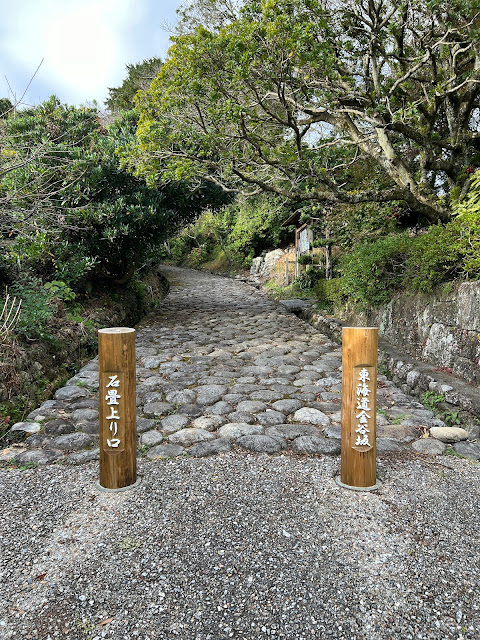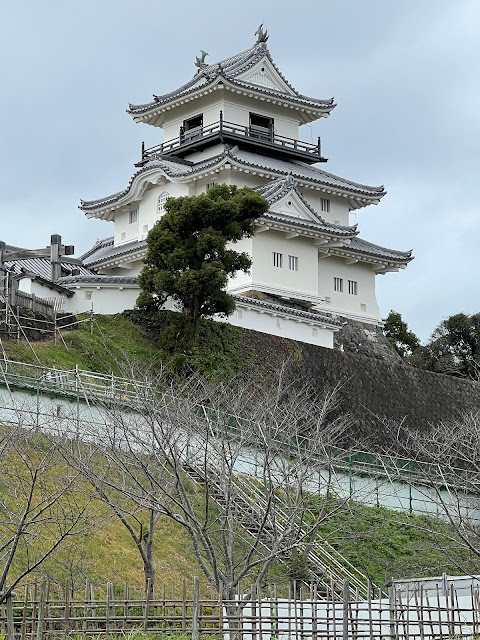A more overcast and humid day, but still good conditions for walking.
My hotel offers a free buffet breakfast, which I couldn’t pass up, so by the time I caught the train from Hamamatsu back to Kanaya I was a little later than previous mornings. No matter.
From the station, the Old Tokaido climbed steeply, and it wasn’t long before I encountered another section of the dreaded ishidatami.
Although just as steep as the section near Hakone, this was in better condition and nowhere near as long. Still, it’s not easy walking, and once again I was glad of the pole. I agree with the Temple Guy: this is much harder than Satta Pass, and I’m surprised it doesn’t have more of a reputation on the walk. Once the ishidatami ends, there’s still plenty of hill to climb, and the route rises through tea plantations.
On those grey poles are electric fans: I’ve read that they’re used on still, humid mornings to blow away the mist that could otherwise damage the leaves.
Where the bushes are in bloom, it’s easy to see the tea plant’s relation to the camellia family:
Tea plantations are very picturesque, and I had a few goes trying to get the perfect shot. Didn’t succeed, of course, but here are the attempts:
At the top of the hill is the site of Suwahara Castle. Nothing is now visible above ground, but to judge from the depth of the moats that remain it must have been an impressive place:
The road followed the ridge for a couple of kilometres of beautifully flat walking with amazing views, before dropping steeply to the village of Kikugawa. The way down featured more ankle-threatening ishidatami, of course.
And once through the village another steep climb up the other side of the valley, this time thankfully entirely on paved surface. This was really pleasant rural walking, with few cars on the narrow roads. Eventually the route descended to the post town of Nissaka, from where a very familiar pattern resumed: broadly tracking National Route 1, and sometimes using it, but more often weaving left and right, and crossing on the diagonal.
At Kakegawa, an important castle town, I made a small deviation to view the reconstructed castle tower but decided not to pay the 500 yen entrance fee to look around properly.
As I walked down the hill back towards the Old Tokaido, I heard a friendly shout, and was invited to join a small group of people outside a shop. The man who’d called me over spoke good English, and explained that the shop sold items relating to Samurai Japan. The other man in the group was the shop owner. I explained where I was from and what I was doing in Japan, and many expressions of astonishment and words of encouragement were offered. After that I felt the least I could do was to go in and have a look around, and I bought a keyring with the name of Oda Nobunaga, a famous Samurai warlord, to hang on my pack. It also has a little bell to scare off bears.
As usual, I asked if I could take a photo, and they happily agreed. So here are Ouba-san, Takuya-san and Matsuyama-san (the shop owner is on the right).















Comments
Post a Comment